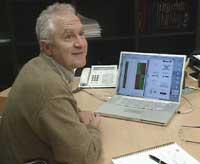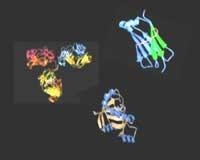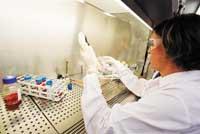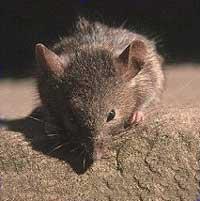Proteomics against liver diseases
2004/06/09 Agirre Ruiz de Arkaute, Aitziber - Elhuyar Zientzia

José María Mato, a scientist at the new CIC-Biogune research center in Zamudio, has been investigating a serious liver disease for more than 20 years: steatohepatitis. It occurs when too much fat or fat accumulates in the liver and ends up causing cirrhosis. In the worst case, also cancer.
This disease cannot be diagnosed until the patient receives symptoms and is too late, since by then the disease cannot be reversed. For this reason, José María Mato wants to find a way to diagnose steatohepatitis from the beginning. "We want to know which genes and which proteins change in this early phase of the disease. In this way we can know who and when the disease will develop. The prediction of diseases is the greatest challenge of medicine at the beginning of this millennium."
A few years ago, Mato identified a gene of great importance in steatohepatitis. But he knows that this is not enough. Now, instead of analyzing the genes separately, it analyzes the proteins that are generated from them. "Genes only keep information. What they do is return it and create a protein. But at the end in the cell the real workers are the same proteins."
Therefore, proteomics is the new challenge of biology. This allows to know all the proteins present in each cell. It is much more complicated than sequencing genes.
And it is that as we develop living things proteins are changing; in our cells the same proteins are not formed during the embryo phase or old age. Caterpillars and butterflies also have the same genes, but it is evident that proteins and, therefore, their appearance are different. And when some disease occurs, the same thing happens: proteins change. Proteomics allows us to know which proteins are generated or modified in each disease.

Scientists currently have powerful tools to carry out these studies. In recent years, two-dimensional classrooms and mass spectrometry have begun to be common. These techniques allow to see and analyze hundreds or thousands of proteins at the same time at a very high speed. Proteomics allows to analyze diseases from a totally different perspective to the current one. To put it in some way, seeing what proteins occur when we are sick, scientists get a kind of fingerprint of the disease.
The aim of Mato is to find this fingerprint of steatohepatitis. It is about creating a diagnostic chip on the proteins that change at the time of the onset of the disease, in order to be able to visualize quickly and easily the presence of these proteins in the blood of any patient.

Gai honi buruzko eduki gehiago
Elhuyarrek garatutako teknologia






